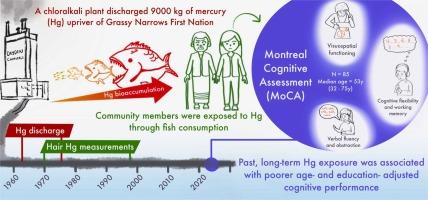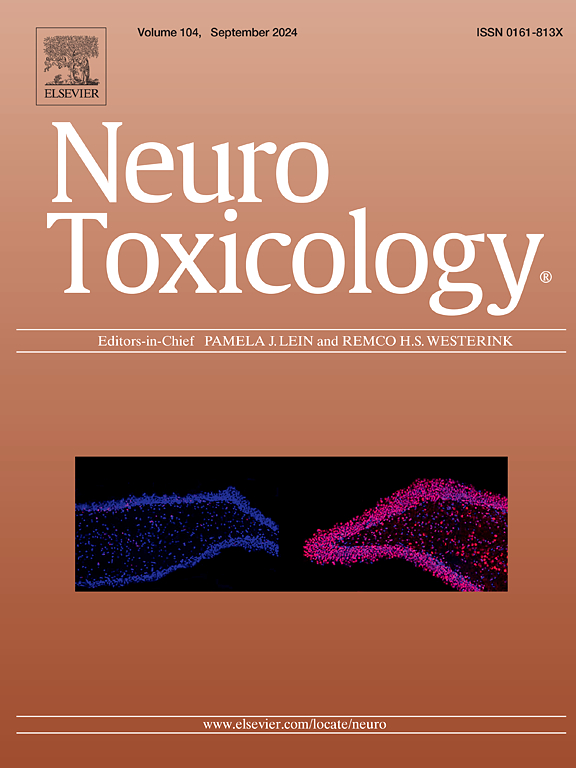加拿大安大略省北部第一民族社区的长期汞暴露和认知功能。
IF 3.9
3区 医学
Q2 NEUROSCIENCES
引用次数: 0
摘要
产前、童年和目前通过食用鱼类接触汞(Hg)都与认知缺陷有关,但关于成年人长期接触汞的后果的信息很少。自1962年以来,格拉斯狭窄第一民族一直暴露在工业排放的汞中。头发汞(HHg)的平均浓度最初非常高,随着时间的推移而下降,并在20世纪90年代稳定下来。蒙特利尔认知评估(MoCA)测试结果分析了85名年龄在32-75岁(中位数:53岁)的人在1970年至1997年之间基于年份的回顾性HHg测量和当前的血液汞含量。由于MoCA尚未在土著人群中得到临床验证,因此使用了年龄和教育调整分数的残差(MoCA-r分数)。最大HHg高四分位数人群的MoCA-r评分较低(p = 0.007)。测试项目的聚类产生了三个聚类,分别代表语言流畅性和抽象性,认知灵活性和工作记忆,以及视觉空间功能。为了模拟HHg随时间的演变,对重复HHg测量≥10年的人进行纵向混合效应模型(LMEM)。较高的长期既往HHg与较低的MoCA-r和所有聚类得分相关。MoCA-r或聚类评分与血汞没有关联,这反映了最近的暴露。研究结果表明,即使目前的平均浓度降至建议指导值以下,几十年后的遗留暴露也会影响认知功能。前瞻性研究可以提供有关下降速度和当前接触可能产生的未来影响的信息。本文章由计算机程序翻译,如有差异,请以英文原文为准。

Long-term mercury exposure and cognitive functions in a First Nation community in Northern Ontario, Canada
Prenatal, childhood, and current mercury (Hg) exposure through fish consumption have each been associated with cognitive deficits, but little information exists on the consequences of long-term exposure among adults. Since 1962, Grassy Narrows First Nation has been exposed to Hg from an industrial discharge. Average Hair Hg (HHg) concentrations, initially very high, decreased over time and stabilized in the 1990’s. Montreal Cognitive Assessment (MoCA) test outcomes were analyzed in 85 persons aged 32–75 y (median: 53 y) with respect to retrospective year-based HHg measurements between 1970 and 1997 and current blood Hg. Since the MoCA has not been clinically validated for Indigenous populations, residuals of age- and education-adjusted scores were used (MoCA-r scores). Lower MoCA-r scores were observed among persons in the higher quartile of maximum HHg compared to those in the lower quartile (p = 0.007). Clustering of the test items yielded 3 clusters representing verbal fluency and abstraction, cognitive flexibility and working memory, and visuospatial functioning. To model the evolution of HHg over time, longitudinal mixed effect models (LMEM) were performed with persons with ≥ 10 repeated year-based HHg measurements. Higher long-term past HHg was associated with lower MoCA-r and all cluster scores. No association was observed between MoCA-r or cluster scores and blood Hg, which reflects recent exposure. The findings suggest that legacy exposure can affect cognitive functioning decades later, even when average current concentrations have decreased to below recommended guidelines. Prospective studies could provide information on the rate of decline and the possible future impact of current exposure.
求助全文
通过发布文献求助,成功后即可免费获取论文全文。
去求助
来源期刊

Neurotoxicology
医学-毒理学
CiteScore
6.80
自引率
5.90%
发文量
161
审稿时长
70 days
期刊介绍:
NeuroToxicology specializes in publishing the best peer-reviewed original research papers dealing with the effects of toxic substances on the nervous system of humans and experimental animals of all ages. The Journal emphasizes papers dealing with the neurotoxic effects of environmentally significant chemical hazards, manufactured drugs and naturally occurring compounds.
 求助内容:
求助内容: 应助结果提醒方式:
应助结果提醒方式:


